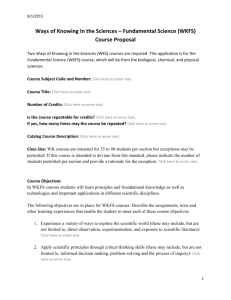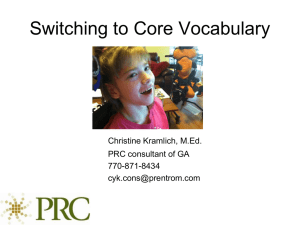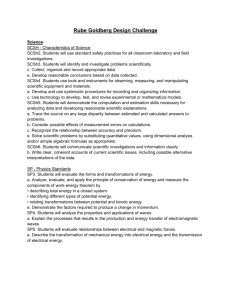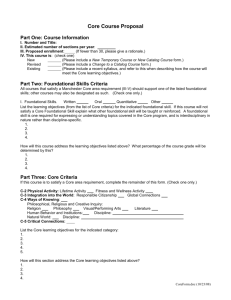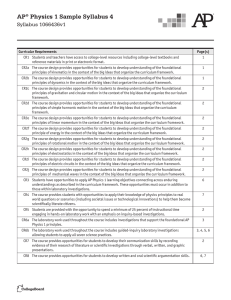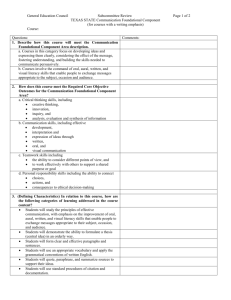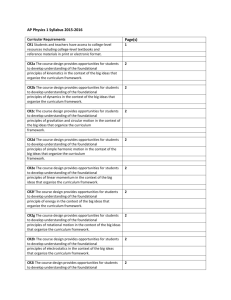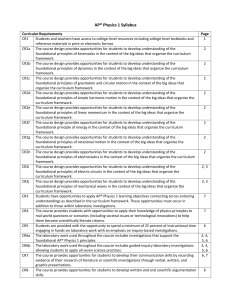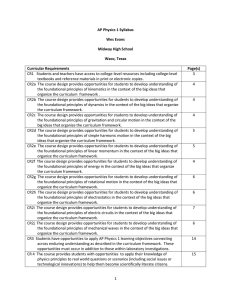AP Physics 2 Syllabus
advertisement
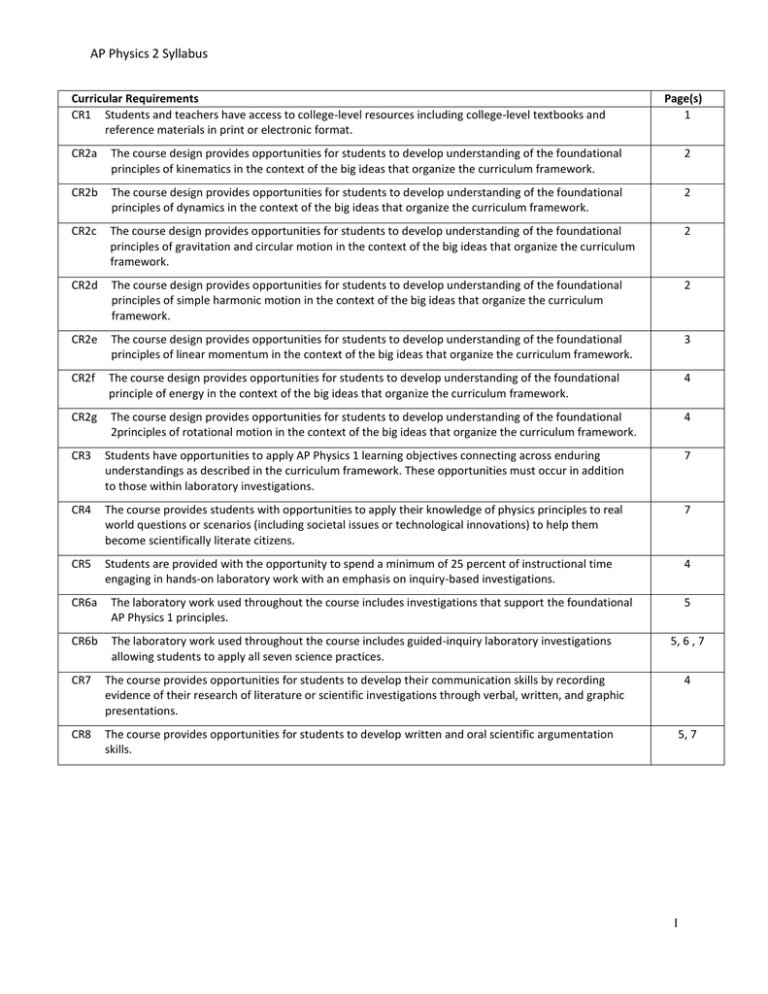
AP Physics 2 Syllabus Curricular Requirements CR1 Students and teachers have access to college-level resources including college-level textbooks and reference materials in print or electronic format. Page(s) 1 CR2a The course design provides opportunities for students to develop understanding of the foundational principles of kinematics in the context of the big ideas that organize the curriculum framework. 2 CR2b The course design provides opportunities for students to develop understanding of the foundational principles of dynamics in the context of the big ideas that organize the curriculum framework. 2 CR2c The course design provides opportunities for students to develop understanding of the foundational principles of gravitation and circular motion in the context of the big ideas that organize the curriculum framework. 2 CR2d The course design provides opportunities for students to develop understanding of the foundational principles of simple harmonic motion in the context of the big ideas that organize the curriculum framework. 2 CR2e The course design provides opportunities for students to develop understanding of the foundational principles of linear momentum in the context of the big ideas that organize the curriculum framework. 3 CR2f The course design provides opportunities for students to develop understanding of the foundational principle of energy in the context of the big ideas that organize the curriculum framework. 4 CR2g The course design provides opportunities for students to develop understanding of the foundational 2principles of rotational motion in the context of the big ideas that organize the curriculum framework. 4 CR3 Students have opportunities to apply AP Physics 1 learning objectives connecting across enduring understandings as described in the curriculum framework. These opportunities must occur in addition to those within laboratory investigations. 7 CR4 The course provides students with opportunities to apply their knowledge of physics principles to real world questions or scenarios (including societal issues or technological innovations) to help them become scientifically literate citizens. 7 CR5 Students are provided with the opportunity to spend a minimum of 25 percent of instructional time engaging in hands-on laboratory work with an emphasis on inquiry-based investigations. 4 CR6a The laboratory work used throughout the course includes investigations that support the foundational AP Physics 1 principles. 5 CR6b The laboratory work used throughout the course includes guided-inquiry laboratory investigations allowing students to apply all seven science practices. 5, 6 , 7 CR7 The course provides opportunities for students to develop their communication skills by recording evidence of their research of literature or scientific investigations through verbal, written, and graphic presentations. 4 CR8 The course provides opportunities for students to develop written and oral scientific argumentation skills. 5, 7 I AP Physics 2 Syllabus Course Introduction Textbook: Etkina, Eugenia, Gentile, Michael and Van Heuvelen, Alan. College Physics. 1st Edition. New York: Pearson, 2014. [CR1] About this course: The AP Physics 2 course will meet for 90 minutes every day. Lab work is integral to the understanding of the concepts in this course. The AP Physics 2 Course has been designed by the College Board as a course equivalent to the algebra-based, collegelevel physics class. At the end of the course, students will take the AP Physics 2 Exam, which will test their knowledge of both the concepts taught in the classroom and their use of the correct formulas. Emphasis will be placed on understanding physical science literacy and applying physics concepts to think critically and solve problems. Physics 1 should be taken before this course, which covers traditional mechanics and other important introductory topics. CR1— Students and teachers have access to college-level resources including college-level textbooks and reference materials in print or electronic format. The content for the course is based on six big ideas: Big Idea 1 – Objects and systems have properties such as mass and charge. Systems may have internal structure. Big Idea 2 – Fields existing in space can be used to explain interactions. Big Idea 3 – The interactions of an object with other objects can be described by forces. Big Idea 4 – Interactions between systems can result in changes in those systems. Big Idea 5 – Changes that occur as a result of interactions are constrained by conservation laws. Big Idea 6 – Waves can transfer energy and momentum from one location to another without the permanent transfer of mass and serve as a mathematical model for the description of other phenomena. Big Idea 7 – The mathematics of probability can be used to describe the behavior of complex systems and to interpret the behavior of quantum mechanical systems. Evaluation: Students will get grades on quizzes, laboratory work, projects, and exams. Exams are typically worth 100 points and will consist of questions similar to ones students will see on the AP Exam. Homework assignments and quizzes will consist of problems from the textbook, supplements, and old AP Exams. Projects are longterm, and typically will involve groups of students developing a plan, collecting data and/or research, and presenting conclusions in a meaningful way. Laboratory work is student centered and inquiry based and is discussed below. Grades will be determined by taking the number of points a student has earned and dividing it by the total number of points that the student could have achieved. This decimal is multiplied by 100, and that will be the student’s grade. 1 AP Physics 2 Syllabus CR2b— The course Topics Covered: 1. Introduction - weeks 1-2 Big Ideas: 3 and 5 * 3.A, 3.B, and 5.D A. Review of physical quantities (chapter 1) B. Algebra and trigonometry review C. Newton’s biggest hits (review of important Physics 1 topics) 2. Fluid Mechanics (chapter 15) - weeks 3-4 Big Ideas: 1, 3, and 5 [CR2b] *1.E, 3.C, 5.B, and 5.F A. Density and Pressure 1. Density and specific gravity 2. Pressure as a function of depth 3. Pascal’s principle B. Buoyancy 1. Buoyant force 2. Archimedes’ principle C. Fluid flow continuity D. Bernoulli’s Equation 3. Thermal Physics (chapters 16, 17, and 18) - weeks 5-9 Big Ideas: 1, 4, 5, and 7 [CR2a] *1.E, 4.D, 4.E, 5.B, 7.A, and 7.B A. Temperature and Heat 1. Mechanical equivalent of heat 2. Heat transfer and thermal expansion B. Kinetic Theory 1. Ideal gases 2. Gas laws C. Thermodynamics 1. Thermodynamic processes a. Adiabatic b. Isothermal c. Isobaric d. Isochoric e. Cyclic 2. pV diagrams a. Determining work done b. Interpreting graphs 3. First Law of Thermodynamics a. Internal energy b. Energy conservation 4. Second Law of Thermodynamics a. Entropy b. Heat engines c. Carnot cycle 4. Electricity (chapters 19, 20, and 21) - weeks 10-14 Big Ideas: 1, 2, 3, 4, and 5 [CR2c] [CR2d] *1.E, 2.A, 2.C, 2.D, 2.E, 3.A, 3.C, 3.G, 4.E, 5.B, and 5.C A. Electrostatics 1. Coulomb’s Law 2. Electric Field design provides opportunities for students to develop understanding of the foundational principles of fluids in the context of the big ideas that organize the curriculum framework. CR2a— The course design provides opportunities for students to develop understanding of the foundational principles of thermodynamics in the context of the big ideas that organize the curriculum framework. CR2c— The course design provides opportunities for students to develop understanding of the foundational principles of electrostatics in the context of the big ideas that organize the curriculum framework. CR2d— The course design provides opportunities for students to develop understanding of the foundational principles of electric circuits in the context of the big ideas that organize the curriculum framework. 2 AP Physics 2 Syllabus a. Force on a test charge b. Field diagrams c. Motion of particle in an E field 3. Electric Potential a. Due to a group of charges b. Potential difference c. Work on a charge d. Between parallel plates 4. Electrostatics with Conductors a. Absence of E field in conductor b. Equipotential c. Charging by induction B. Capacitors 1. Capacitance 2. Energy and charge stored 3. Parallel plates C. Electric Current 1. Definition of direction of current 2. Ohm’s Law 3. Resistance and Resistivity 4. Power D. DC Circuits 1. Schematic diagrams/Kirchhoff’s Laws 2. Resistors a. In series b. In parallel 3. Capacitors a. In series b. In parallel 4. Terminal voltage and internal resistance 5. Steady-state RC circuits 5. Magnetism (chapters 22 and 23) - weeks 15-16 Big Ideas: 2, 3, and 4 [CR2e] *1.E, 2.A, 2.B, 2.E, 3.G, 4.E, and 5.B A. Magnetostatics 1. Magnetic field 2. Forces on moving charges 3. Forces on a current-carrying wire 4. Magnetic field of current-carrying wires B. Electromagnetism 1. Magnetic flux 2. Faraday’s Law and Lenz’s Law 3. Induced emf and induced current 6. Optics (chapters 25, 26, 27, and 28) - weeks 17- 22 Big Idea 6 [CR2f] *1.D, 5.D, 6.A, 6.B, 6.C, 6.D, 6.E, 6.F, and 6.G A. Physical Optics 1. The electromagnetic spectrum 2. Interference a. Two-source interference 3. Diffraction a. Diffraction grating 4. Thin films CR2e— The course design provides opportunities for students to develop understanding of the foundational principles of magnetism and electromagnetic induction in the context of the big ideas that organize the curriculum framework. 3 AP Physics 2 Syllabus B. Geometric Optics 1. Reflection and refraction a. Snell’s Law b. Total internal reflection 2. Images formed by mirrors a. Ray diagrams b. Thin lens/mirror equation 3. Images formed by lenses a. Ray diagrams b. Thin lens/mirror equation 7. Atomic and Nuclear Physics (chapters 30, 31, and 32) - weeks 25 – 28 Big Ideas: 1, 3, 4, 5, 6, and 7 [CR2g] * 1.A, 1.B, 1.C, 1.D, 3.G, 4.C, 5.B, 5.D, 5.G, and 7.C A. Atomic Physics and Quantum Effects 1. Discovery of the Electron and Atomic Nucleus a. Cathode ray tube b. Millikin’s Oil Drop Experiment c. Rutherford scattering 2. Photons and the Photoelectric Effect a. Energy of a photon b. Intensity and number of photons c. Stopping potential 3. Bohr Model a. Energy levels b. Emission and absorption spectra c. Transition between energy levels 4. DeBroglie Wavelength a. Wavelength of Particles 5. Production of X-rays 6. Compton Scattering B. Nuclear Physics 1. Atomic number, mass number, and atomic mass 2. Nuclear processes a. Radioactive decay (alpha, beta, and gamma) b. Fusion c. Fission 3. Mass-Energy equivalence 8. Modern Physics and Review for AP Exams - weeks 29-32 Laboratory Activities: Twenty five percent of the course will be lab work. [CR5] Labs may take several inclass days to finish, and students may have to do work outside of class as well. Students are expected to keep a lab notebook where they will maintain a record of their laboratory work. Lab reports will consist of the following components: [CR7] Title Objective/Problem Design (if applicable): If the lab has no set procedure, what is to be done? Why are you doing it this way? Data: All data gathered in the lab will go here Calculations/Graphs: Calculations are done here. Any graphs that need to be made go here. CR2f— The course design provides opportunities for students to develop understanding of the foundational principles of optics in the context of the big ideas that organize the curriculum framework. CR2g— The course design provides opportunities for students to develop understanding of the foundational principles of modern physics in the context of the big ideas that organize the curriculum framework. CR5— Students are provided with the opportunity to spend a minimum of 25 percent of instructional time engaging in hands-on laboratory work with an emphasis on inquirybased investigations. CR7— The course provides opportunities for students to develop their communication skills by recording evidence of their research of literature or scientific investigations through verbal, written, and graphic presentations. 4 AP Physics 2 Syllabus Conclusion: Data analysis occurs here, and a statement can be made about what was learned in the lab. Error analysis also occurs here. Evaluation of the lab occurs here as well. Every major unit will have an inquiry-based lab, and inquiry-based labs will make up no less than half of the laboratory work. Collectively, laboratory work will engage students in all seven science practices. Laboratory List [CR6a] These laboratory experiences have two versions: one is a guided-inquiry, formative student exploration of the topic; the other is a traditional approach, which is summative in nature. For all the guided-inquiry labs, students will be required to present their data and calculations to the class and be prepared to defend their analysis and conclusions. Labs may need to be redesigned and re-run. [CR8] Name Measurement and Propagation of Uncertainty OpenShort Description Inquiry or GuidedInquiry [CR6b] Students will use a N Fluids: Archimedes’ Principle Y Relationship between pressure and volume Y Gas Properties PhET Simulation N Investigating Equipotential Lines and Electric Fields Y pendulum to take scientific measurements and estimate and calculate the amount of uncertainty of those measurements. Students will determine the density of an unknown fluid and an unknown solid using a fluid of known density and other standard equipment. Use the pressure/volume syringe or the Pasco pressure/volume interface to design an experiment related to the ideal gas equation. The students will explore the relationships between pressure volume, temperature and number of moles for an ideal gas using the “Gas Properties” simulation. Students will draw lines of equal electrostatic potential and electric field lines for various charge configurations and determine the dependence of the electrostatic potential on Science Practices 2 and 5 CR6a— The laboratory work used throughout the course includes a variety of investigations that support the foundational AP Physics 2 principles. CR8— The course provides opportunities for students to develop written and oral scientific argumentation skills. CR6b— The laboratory 1, 2, 4, 5, and 6 work used throughout the course includes guided-inquiry laboratory investigations allowing students to apply all seven science practices. 1, 2, 4 and 5 1, 2, 3, 4, 5, and 6 1, 2, 3, 4, and 5 5 AP Physics 2 Syllabus Understanding Ohm’s Law Y Investigating Magnetic Fields Y Measurement of the Earth’s Magnetic Field Y Electromagnetic Induction Y Using Snell’s Law Y Understanding Geometric Optics Y Focal Length of a Lens Y Double Slit Interference Y Analyzing Emission Spectra N the distance from a point charge. Students will analyze the relationship among current, voltage, and resistance by designing circuits with different resistors and resistor combinations. Students will determine the magnetic field around magnets and represent this information as magnetic field lines. Students will apply Ampere’s Law to measure the strength of the horizontal component of the earth’s magnetic field in the lab room. Students will qualitatively observe the transfer of energy between two coils. Determine how the ratio of number of coils affects the voltage and current in each coil. Students will use Snell’s Law to design an experiment to determine the index of refraction of an unknown substance. Students will design a lab to gain understanding of the types of images formed by various mirrors and lenses. Students will design an experiment to measure the length of a converging lens and a diverging lens. Students will design an experiment to determine the spacing between two narrow slits based upon an analysis of the interference pattern from monochromatic light. Students will compare and contrast the emission spectra of various gases, and investigate 1, 2, 3, 4, and 7 1, 2, and 4 CR6b— The laboratory 1, 2, 3, and 4 work used throughout the course includes guided-inquiry laboratory investigations allowing students to apply all seven science practices. 1, 2, 4, and 5 1, 2, 3, and 4 1, 2, and 5 1, 2, and 4 1, 2, and 4 1, 2, and 3 6 AP Physics 2 Syllabus Modeling Radioactive Decay N quantitatively the emission spectrum of hydrogen and relate it to Bohr’s theory of atomic structure. Students will simulate radioactive decay using various types of dice. 1 and 2 CR6b— The laboratory work used throughout the course includes guidedinquiry laboratory investigations allowing students to apply all seven science practices. CR4— The course Real World Physics Solutions: The students are presented with the following scenario: the local power company wants to build a nuclear reactor in the district. The town council is hearing arguments to decide on whether to pass an ordinance allowing or forbidding the construction of nuclear power plants in city limits. Students will engage in a classroom debate on the merits and drawbacks of nuclear fission reactors. The students will be divided into three groups: one group will argue in favor of the nuclear power plant, one group will argue against the nuclear power plant and one group will serve as the town council and hear arguments. Both groups must use scientific-based evidence to construct their arguments [Essential Knowledge 4.C.4] [CR4] [CR8] Activity to Cross Enduring Understandings [CR3] Students will design a cardboard boat that will safely allow two passengers to cross a pool and come back. Students must include boat design features and calculations to show how their boat design should float. [LO 1.E.11, 1.E.1.2, 3.A.4.1, 3.A.4.2, 3.A.4.3, 3.B.1.4] provides students with opportunities to apply their knowledge of physics principles to real world questions or scenarios (including societal issues or technological innovations) to help them become scientifically literate citizens. CR8— The course provides opportunities for students to develop written and oral scientific argumentation skills. CR3— Students have opportunities to apply AP Physics 2 learning objectives connecting across enduring understandings as described in the curriculum framework. These opportunities must occur in addition to those within laboratory investigations. 7
